Structures and mechanical behaviors of soft nanotubes confining adhesive single or multiple elastic nanoparticles. (pdf, doi)
J. Mech. Phys. Solids 137, 103867 (2020). by Z. M. Wu and X. Yi

Using the Helfrich membrane model, we analyze single-particle and periodic multi-particle wrapping in soft membrane nanotubes. For rigid nanoparticles, analytical solutions based on catenoid, torus, and hyperboloid configurations predict nanotube deformation and morphology. Softer particles undergo greater elastic deformation, reducing adhesion energy in partial wrapping but increasing it in full wrapping. Cooperative wrapping dominates at low membrane tension and remains favorable for soft particles even at high tension. Wrapping phase diagrams reveal diverse states, including bulged cylinders, prolate necklaces, and sausage-shaped tubes.
Nanoparticle elasticity regulates phagocytosis and cancer cell uptake. (pdf, doi)
Sci. Adv. 6, eaaz4316 (2020). by Y. Hui et al.
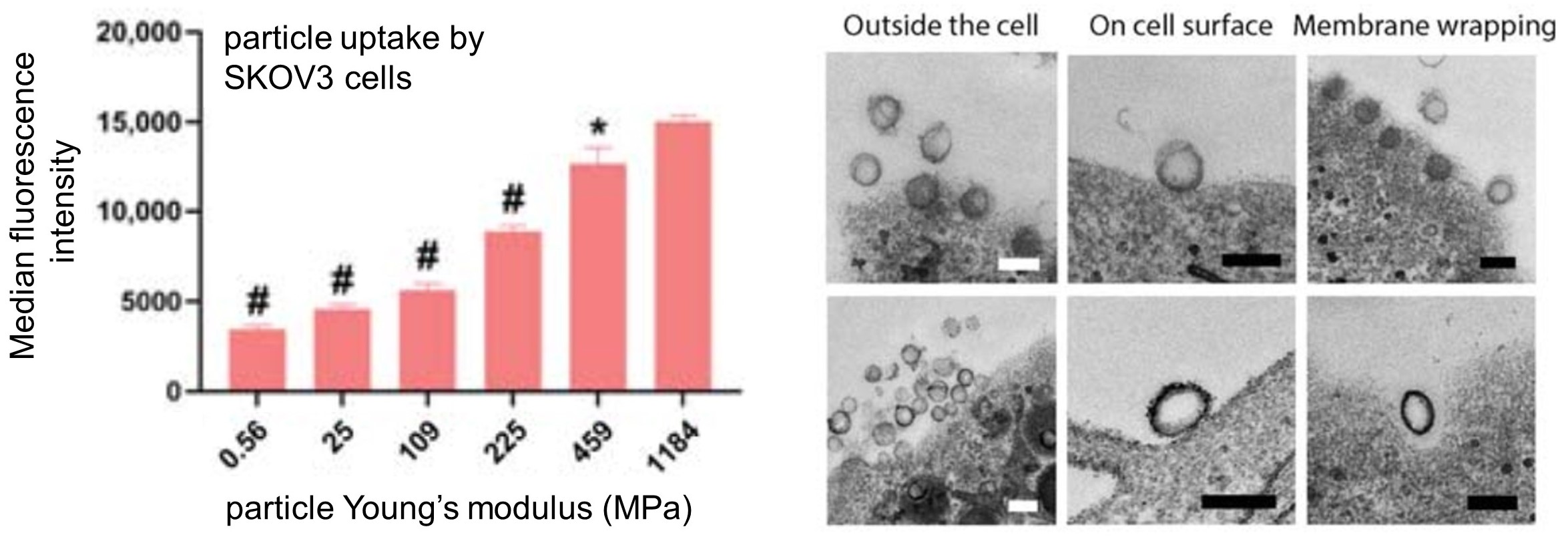
We demonstrate that effects of nanoparticle (NP) elasticity on cellular uptake depends on the type of cell-NP interaction. For macrophage phagocytosis and receptor-mediated endocytosis, NP elasticity significantly influences uptake, while cancer cells lose stiffness sensitivity in nonspecific clathrin- and caveolin-independent endocytosis. Ligand-receptor interactions and membrane wrapping deform soft NPs, with adaptor proteins like clathrin and F-actin increasing membrane rigidity during endocytosis. In contrast, clathrin- and caveolin-independent pathways lack sufficient rigidity to deform even soft NPs.
Unified model for size-dependent to size-independent transition in yield strength of crystalline metallic materials. (pdf, doi)
Phys. Rev. Lett. 124, 235501 (2020). by W. B. Liu et al.

We develop a framework that accounts for both dislocation motion and source activation, with the critical resolved shear stress determined by the competition between these mechanisms. Yield strength transitions from size-dependent to size-independent behavior as sample size decreases below a critical length scale. Single crystals exhibit size-independent yield strength when source activation stress is lower than motion stress, while polycrystals show a reverse size effect due to increased grain boundary density.
Dislocation-grain boundary interaction in metallic materials: Competition between dislocation transmission and dislocation source activation. (pdf, doi)
J. Mech. Phys. Solids 145, 104158 (2020). by W. B. Liu et al.
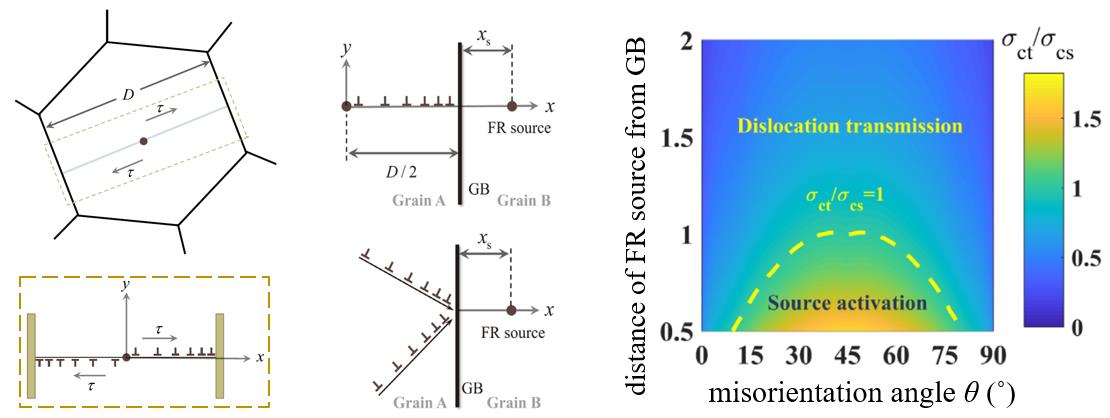
This work presents a theoretical model to study dislocation–grain boundary (GB) interactions, focusing on dislocation transmission and source activation. It quantifies microstructure-dependent interactions and the misorientation angle-driven competition between the two mechanisms. Dislocation transmission occurs when pile-up energy overcomes barriers set by the residual dislocation tensor and GB energy, linking critical stress to the plastic compatibility factor. A realistic model for multiple slip pile-ups reveals lower activation stress and reduced loading direction sensitivity. For <100> tilt GBs, low-angle GBs favor transmission, while high-angle GBs promote source activation.
Nanomechanical characterization of pressurized elastic fluid nanovesicles using indentation analysis. (pdf, doi)
Extreme Mech. Lett. 34, 100613 (2020). by X. Y. Tang et al.
Finite indentation of pressurized elastic fluid nanovesicles by a rigid cylindrical indenter. (pdf, doi)
Acta Mech. Solida Sin. 32, 633–642 (2019). by X. Y. Tang et al.

We theoretically study the mechanical properties of pressurized nanovesicles under parabolic and cylindrical indentation, examining the effects of osmotic pressure, membrane bending rigidity, adhesion energy, and indenter tip size. Larger values of these parameters increase vesicle stiffness and Young's modulus, with osmotic pressure dominating the response. For parabolic indentation, the force increases nonlinearly with depth. For cylindrical indentation, the force rises linearly, peaks, and then slightly decreases as an inward tubular protrusion forms, eventually saturating.
Probabilistic and constitutive models for ductile-to-brittle transition in steels: A competition between cleavage and ductile fracture. (pdf, doi)
J. Mech. Phys. Solids 135, 103809 (2020). by L. R. Chen et al.

A probabilistic model with a temperature-dependent constitutive relationship is proposed to capture the competition between cleavage and ductile void failure in irradiated ferritic/martensitic steels. At low temperatures, cleavage dominates, lowering fracture toughness, while at high temperatures, ductile void growth suppresses cleavage, increasing fracture toughness. Irradiation embrittlement raises the ductile-to-brittle transition temperature through hardening-induced flow stress elevation and plasticity localization, which promote cleavage micro-crack development and weaken resistance from ductile void growth.
Curvature-mediated cooperative wrapping of multiple nanoparticles at the same and opposite membrane sides. (pdf, doi)
Nanoscale 11, 19751–19762 (2019). by Z. S. Yan et al.
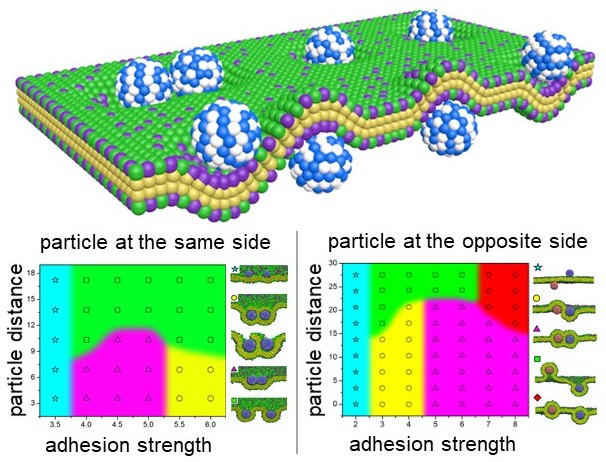
Through molecular dynamics and theoretical analysis, we explore the cooperative wrapping of adhesive nanoparticles on the same or opposite sides of a membrane. On the same side, interactions vary between attraction and repulsion based on particle distance and the balance of membrane bending, binding, and protrusion. On opposite sides, interactions are consistently attractive, enhancing cooperative wrapping. These findings advance the understanding of high-order cooperative assemblies of nanoparticles or proteins in biological processes.
Chain-length- and saturation-tuned mechanics of fluid nanovesicles direct tumor delivery. (pdf, doi)
ACS Nano 13, 7676–7689 (2019). by Z. Dai et al.

By varying lipid chain length and saturation, liposomes with different rigidities are produced. Stiff liposomes show minimal deformation, while soft ones deform irregularly, both hindering their penetration into multicellular spheroids (MCS). Liposomes with intermediate rigidity demonstrate superior diffusion, penetration, and retention in the tumor extracellular matrix and MCS, leading to enhanced tumor suppression. These findings highlight liposome mechanics as a key design parameter for optimizing drug delivery.
Role of nanoparticle mechanical properties in cancer drug delivery. (pdf, doi)
ACS Nano 13, 7410–7424 (2019). by Y. Hui et al.
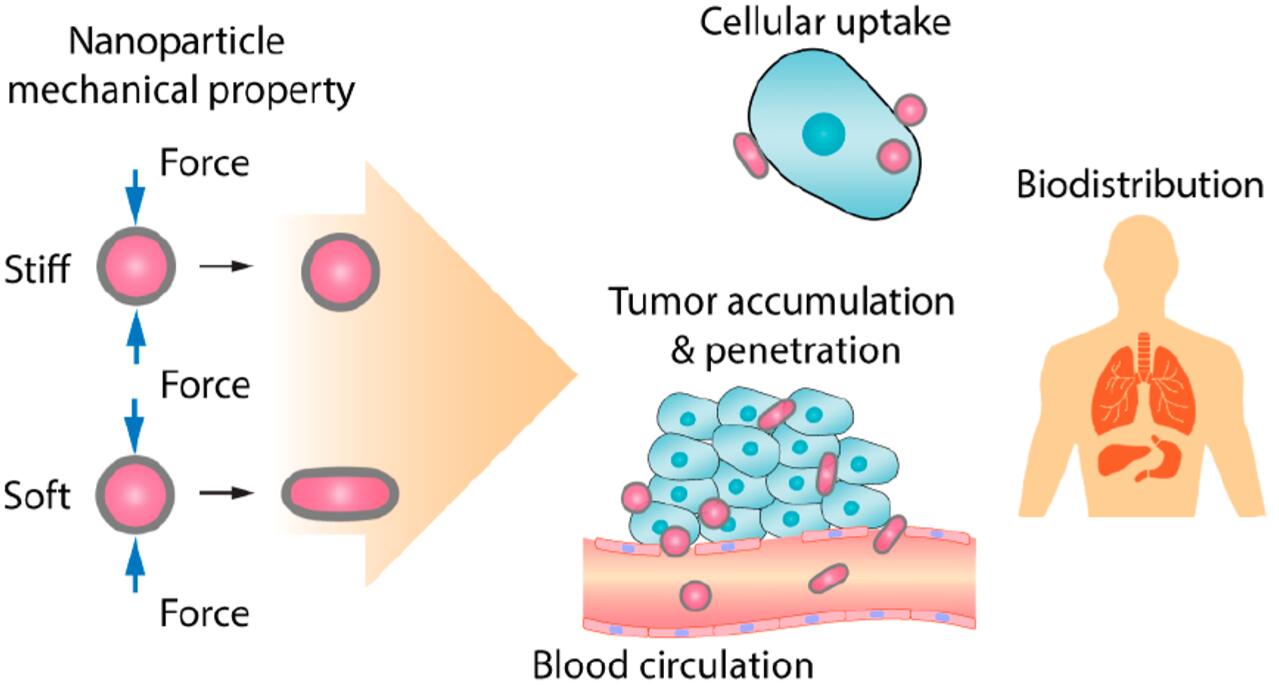
This review outlines the impact of nanoparticle mechanical properties on cancer drug delivery, covering: (1) key terminologies and techniques for characterizing nanoparticle mechanical properties; (2) methods for fabricating nanoparticles with tunable mechanical properties; and (3) in vitro and in vivo studies on the biological performance of stiff and soft nanoparticles, including blood circulation, tumor targeting, penetration, and cancer cell internalization. Special emphasis is placed on mechanisms driving these complex nano-bio interactions at cellular, tissue, and organ levels.
Why are nanoparticles trapped at cell junctions when the cell density is high? (pdf, doi)
Nanoscale 11, 6602–6609 (2019). by T. T. Yue et al.

Our experimental and computational studies reveal that nanoparticles encountering two adjacent cells, as commonly observed in tissues, tend to become trapped at cell junctions, hindering cellular uptake. At high cell densities, the stable extracellular distribution of nanoparticles is governed by the adhesion, bending, and protrusion of membranes from the surrounding cells.
Membrane wrapping efficiency of elastic nanoparticles during endocytosis: Size and shape matter. (pdf, doi)
ACS Nano 13, 215–228 (2019). by Z. Q. Shen et al.
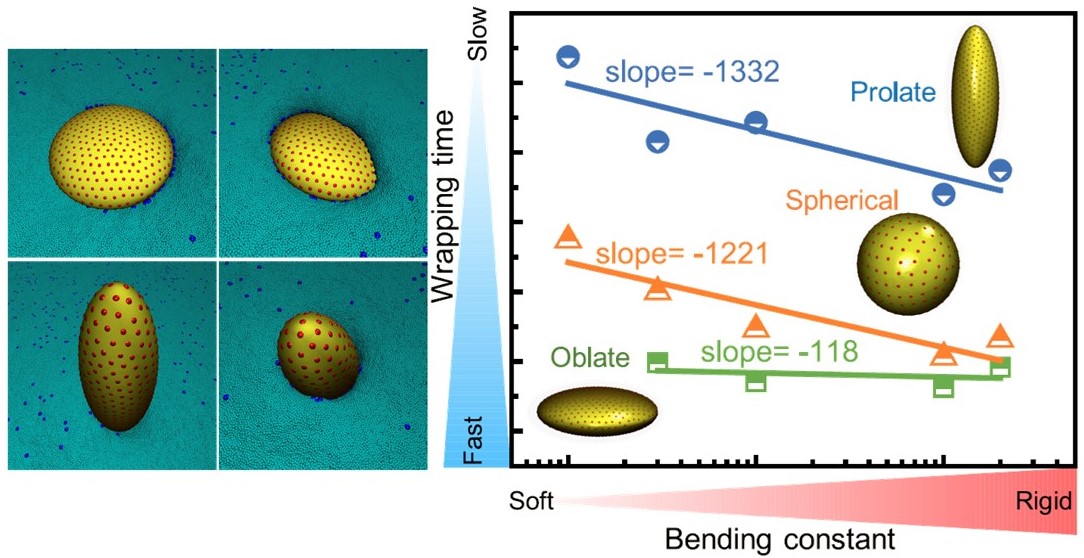
We use MD simulations to investigate receptor-mediated endocytosis of elastic nanoparticles with various sizes and shapes, including spheres, oblates, and prolates. Wrapping efficiency depends on the competition between receptor diffusion kinetics and the thermodynamic driving force from energy variations. Under the volume constraint of particles, the softer spherical nanoparticles are less efficiently be fully wrapped due to their elastic deformation. The difference in wrapping efficiency between soft and rigid spheres grows with particle size. Among the shapes, oblate ellipsoids show the least sensitivity to particle elasticity during membrane wrapping, compared to spheres and prolates.
Temperature- and rigidity-mediated rapid transport of lipid nanovesicles in hydrogels. (pdf, doi)
Proc. Natl. Acad. Sci. U. S. A. 116, 5362–5369 (2019). by M. R. Yu et al.

Liposomes achieve optimal diffusivity when their phase transition temperature aligns with the ambient temperature, marking a significant change in nanovesicle rigidity. Those with a phase transition temperature near body temperature demonstrate enhanced cellular uptake in mucus-secreting epithelium and significantly improve oral insulin delivery efficacy in diabetic rats.
Model of nanoindentation size effect incorporating the role of elastic deformation. (pdf, doi)
J. Mech. Phys. Solids 126, 245–255 (2019). by W. B. Liu et al.
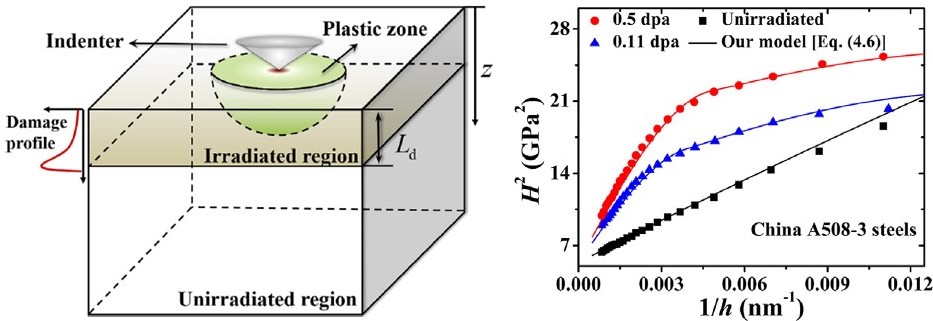
We propose a theoretical model that incorporates elastic deformation to address the indentation size effect. While elastic deformation is typically unrelated to the generation of geometrically necessary dislocations, neglecting elastic deformation can significantly overestimate nanoindentation hardness, particularly at depths below 100 nm. The model's predictions closely match experimental data for nanoindentation of single Cu and MgO crystals, and the approach is further extended to ion-irradiated metallic materials.
Failure of fracture toughness criterion at small scales. (pdf, doi)
Phys. Rev. Mater. 3, 113602 (2019). by Y. Y. Cheng et al.

The size-dependent fracture behavior is revisited. As specimen size decreases to a critical scale, fracture transitions from toughness-controlled to strength-controlled, explaining why microscale tests report significantly lower fracture toughness than macroscale tests. For large specimens, fracture is governed by stress intensity around the crack tip, while for small specimens, it depends on net-section stress. The critical crack length, which determines fracture mechanisms, scales with the ratio of fracture toughness to fracture strength and varies from nanometers for low-toughness materials to millimeters for high-toughness materials.
Multimaterial microfluidic 3D printing of textured composites with liquid inclusions. (pdf, doi)
Adv. Sci. 6, 1800730 (2019). by X. Y. Li et al.
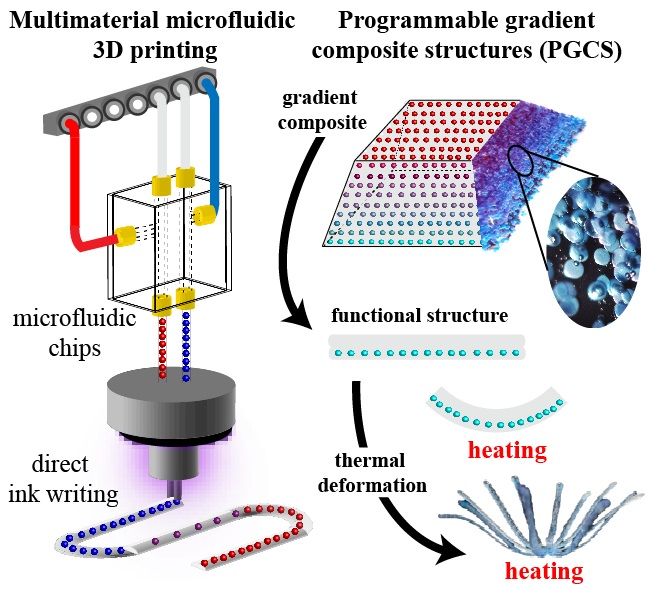
Combining direct ink writing with microfluidics, we develop a novel multimaterial microfluidic 3D printing system for creating textured composites with programmable spatial distributions and liquid inclusions of varied compositions. This versatile framework enables the fabrication of 1D, 2D, and 3D structures, including functional composites such as layered beams with tunable thermal properties and self-healing materials.
Sidewall contact regulating the nanorod packing inside vesicles with relative volumes. (pdf, doi)
Soft Matter 15, 2552–2559 (2019). by Z. M. Wu et al.
Mechanics of cellular packing of nanorods with finite and non-uniform diameters. (pdf, doi)
Nanoscale 10, 14090–14099 (2018). by X. Yi et al.

Theoretical analysis and MD simulations explore the interactions between lipid vesicles and encapsulated rigid nanords with finite diameters and specific geometries. Two scenarios are considered: vesicles with fixed volume and those at given osmotic pressure. The study highlights that contact between vesicle protrusions and nanorod sidewalls, often overlooked, significantly affects vesicle tubulation, membrane tension, and axial forces on the nanorod. It also identifies an optimal filament number for maximizing the length of encapsulated weakly cross-linked filaments in a stable state.
Mechanics of the formation, interaction, and evolution of membrane tubular structures. (pdf, doi)
Biophys. J. 116, 884–892 (2019). by S. X. Li et al.
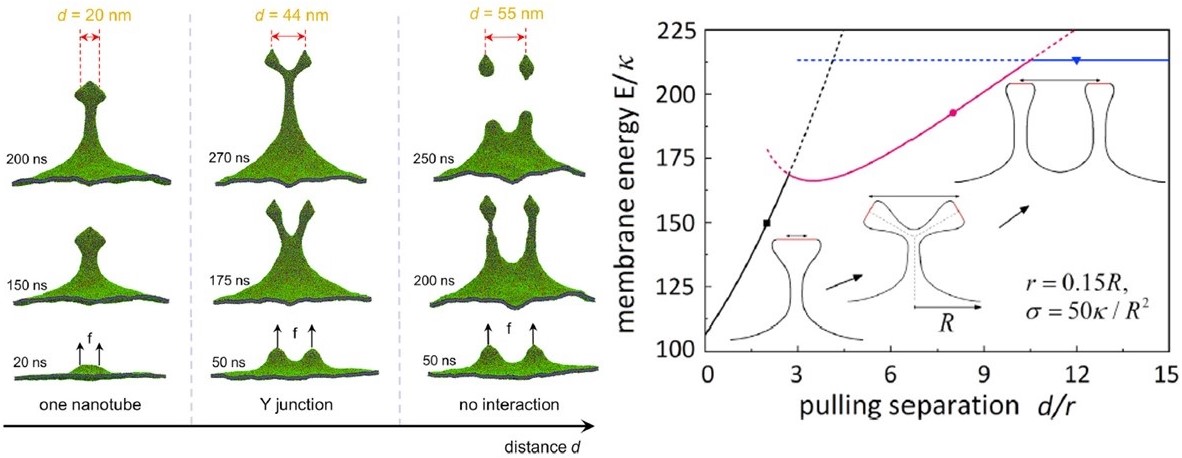
MD simulations and theoretical modeling elucidate the physics of membrane protrusion formation and interaction in lipid membranes. Depending on the pulling displacement and separation distance, various configurations emerge, including single tubular protrusions, V-shaped nanotubes, Y-shaped tubes from coalescence, and weakly interacting protrusions. Lipid flow during shape transitions is analyzed, and the corresponding energy profiles are theoretically estimated.
Force barrier for lipid sorting in the formation of membrane nanotubes. (pdf, doi)
J. Appl. Mech. 86, 121002 (2019). by X. Y. Tang et al.

We conduct a theoretical study on the formation of multicomponent membrane nanotubes and curvature-driven lipid sorting, examining their dependence on the pulling region size. Analytical solutions are derived for the linear force-extraction relation and early-stage membrane configurations. The lipid-disordered phase facilitates nanotube formation by lowering the force barrier. In small pulling regions, the coupling between membrane composition and mechanical properties significantly regulates membrane extraction. However, this effect diminishes as the pulling region expands, with the force barrier becoming dominated by the larger region.
Size-dependent formation of membrane nanotubes: continuum modeling and molecular dynamics simulations. (pdf, doi)
Phys. Chem. Chem. Phys. 20, 3474–3483 (2018). by F. L. Tian et al.
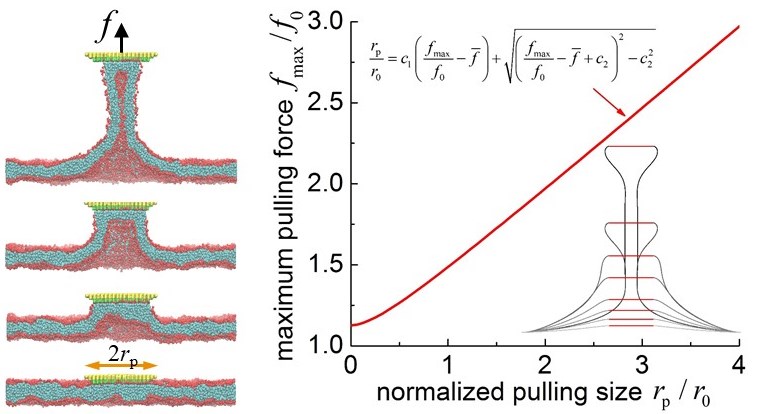
Theoretical analysis and DPD simulations are used to study lipid membrane nanotube formation. As membrane tension and pulling region size increase, the force-extraction curve exhibits discontinuities, and the membrane undergoes a discrete shape transition. A nonlinear relationship between the maximum static pulling force and pulling region size is derived. DPD simulations further reveal that the steady-state force scales linearly with both pulling velocity and region size.
A minimal mechanics model for mechanosensing of substrate rigidity gradient in durotaxis. (pdf, doi)
Biomech. Model. Mechanobiol. 17, 915–922 (2018). by B. Marzban et al.
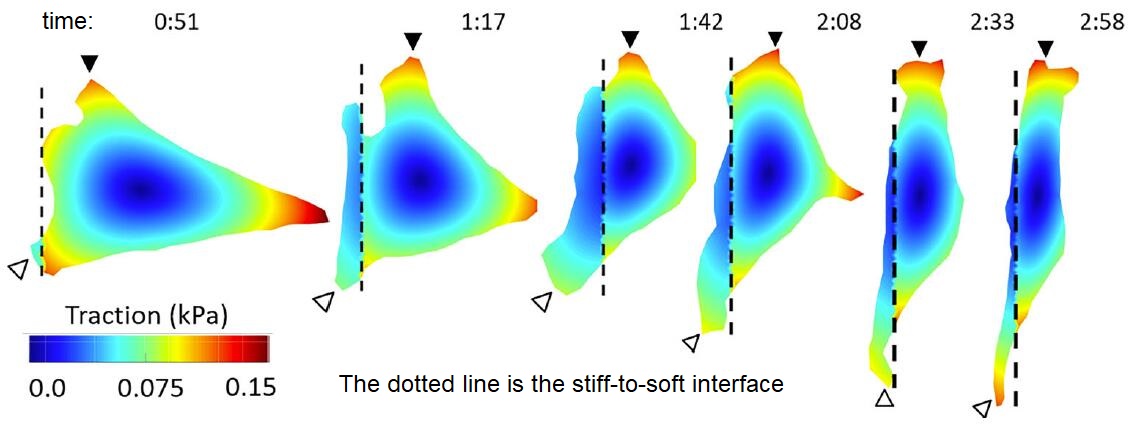
A simple elasticity mechanics model is developed to predict single-cell durotaxis, the directed migration toward mechanically stiffer regions. Incorporating the elasticity of the cytoskeleton, focal adhesion, and extracellular matrix (ECM), the model demonstrates that static cell equilibrium alone can generate larger focal adhesion forces on stiffer ECM regions, driving durotaxis.
Packing of flexible 2D materials in vesicles. (pdf, doi)
J. Phys. D: Appl. Phys. 51, 224001 (2018). by G. J. Zou et al.
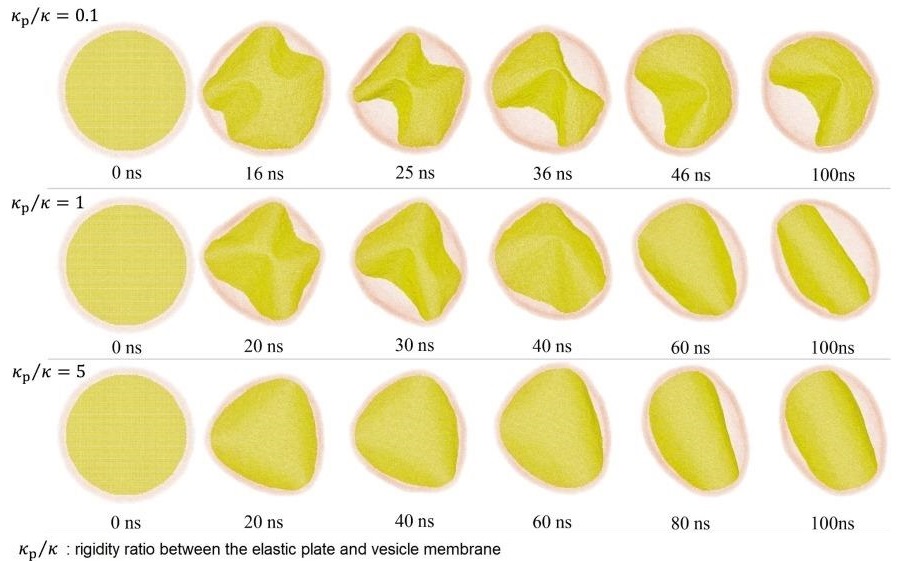
MD simulations and theoretical analysis are used to study the packing of a flexible 2D sheet within a vesicle confinement. The relative size and bending rigidity of the sheet to the vesicle membrane produces diverse packing morphologies, including conical, three-fold symmetric, cylindrically curved, and axisymmetrically buckled shapes. Packing phase diagrams are constructed based on buckling analyses.
Packing of flexible nanofibers in vesicles. (pdf, doi)
Extreme Mech. Lett. 19, 20–26 (2018). by G. J. Zou et al.
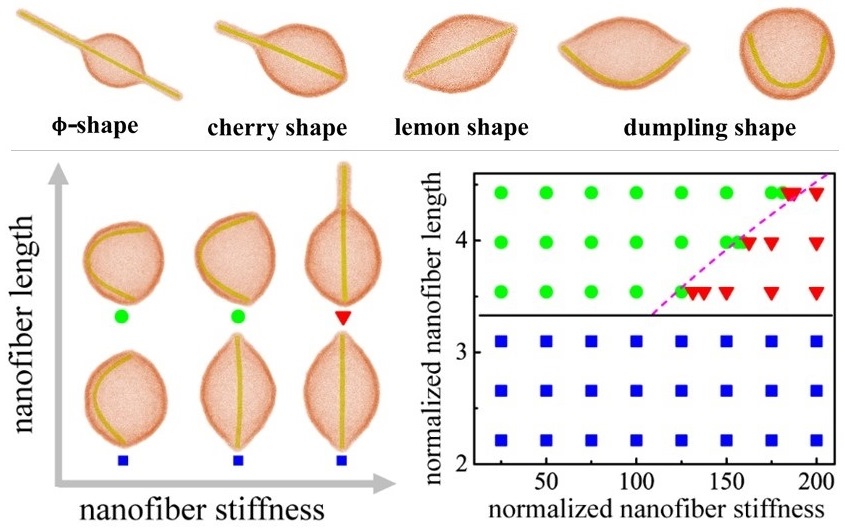
Packing of a flexible nanofiber within an elastic vesicle depends on both the geometrical and material properties of the nanofiber and its initial configuration within the confinement. MD simulations reveal three distinct packing phases—lemon, dumpling, and cherry—based on vesicle morphology. Phase diagrams, mapped in terms of normalized nanofiber length and bending stiffness, align with experimental observations. The influence of osmotic pressure on nanofiber packing is also analyzed.
Kinetics of receptor-mediated endocytosis of elastic nanoparticles. (pdf, doi)
Nanoscale 9, 454–463 (2017). by X. Yi and H. J. Gao
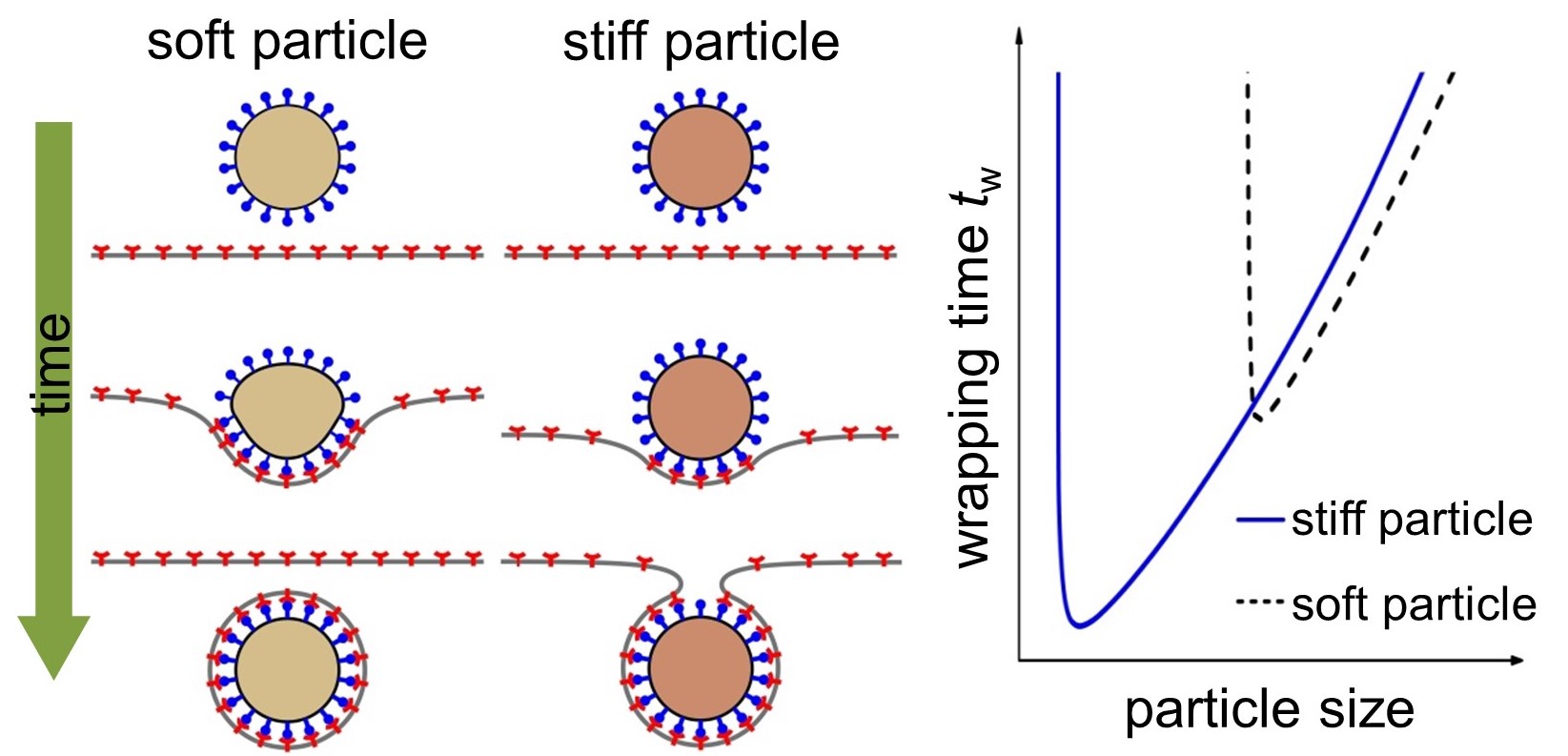
Membrane wrapping of soft nanoparticles is kinetically faster than that of stiff ones. Calculations reveal that membrane tension significantly influences the minimum particle radius but has minimal impact on the wrapping rate. The role of stochastic receptor-ligand binding in endocytosis is also examined.
Incorporation of soft particles into lipid vesicles: Effects of particle size and elasticity. (pdf, doi)
Langmuir 32, 13252–13260 (2016). by X. Yi and H. J. Gao
Budding of an adhesive elastic particle out of a lipid vesicle. (pdf, doi)
ACS Biomater. Sci. Eng. 3, 2954–2961 (2017). by X. Yi and H. J. Gao

Theoretical studies show that incorporating small particles leads to smooth shape evolution, while wrapping large particles by vesicles involves a discontinuous shape transition. For outward budding, a discontinuous shape transformation occurs in vesicles with positive spontaneous curvature but not in those with zero or negative curvature. Additionally, soft particles require greater adhesion energy to achieve full release compared to full wrapping. This suggests that adjusting cell membrane affinity could help retain internalized soft drug agents within the cell, preventing their release via exocytosis.
Nanomechanical mechanism for lipid bilayer damage induced by carbon nanotubes confined in intracellular vesicles. (pdf, doi)
Proc. Natl. Acad. Sci. U. S. A. 113, 12374–12379 (2016). by W. P. Zhu et al.
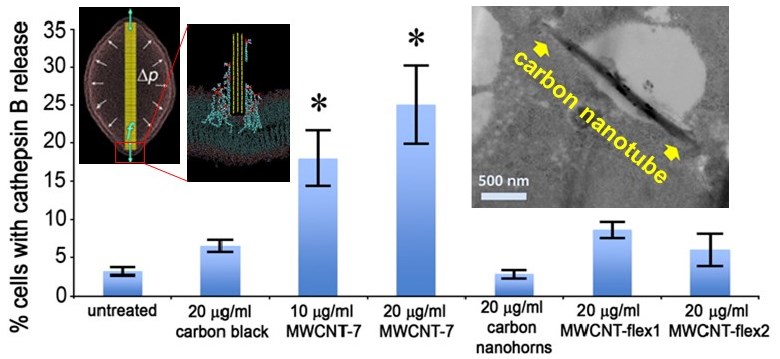
Stiff nanotubes exceeding a critical length are compressed by lysosomal membranes, causing persistent tip contact with the inner membrane leaflet. This interaction extracts lipids, permeabilizes lysosomes, releases cathepsin B into the cytoplasm, and induces cell death, establishing a mechanistic link between nanotube stiffness and cytotoxicity.
Biological and environmental interactions of emerging two-dimensional nanomaterials. (pdf, doi)
Chem. Soc. Rev. 45, 1750–1780 (2016). by Z. Y. Wang et al.

This review proposes a framework for systematically investigating biological behavior through the lens of fundamental materials chemistry and physics. It focuses on three key interaction modes: (i) chemical interactions and phase transformations, (ii) electronic and surface redox interactions, and (iii) physical and mechanical interactions unique to near-atomically-thin, high-aspect-ratio solids.
Cell interaction with graphene microsheets: Near-orthogonal cutting versus parallel attachment. (pdf, doi)
Nanoscale 7, 5457–5467 (2015). by X. Yi and H. J. Gao
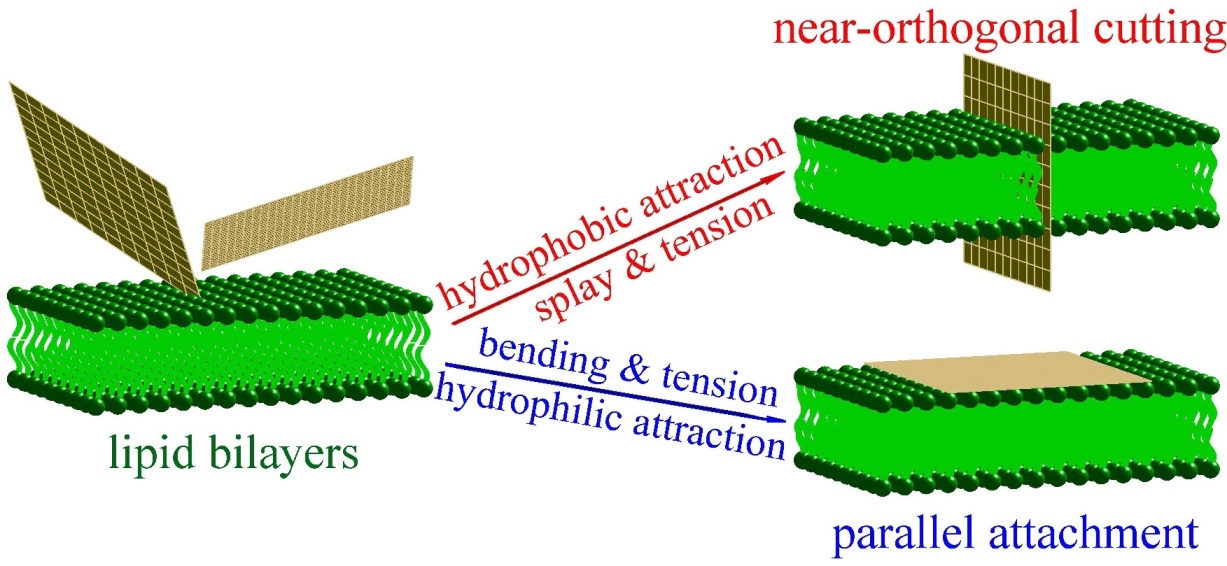
Graphene microsheets interact with cell membranes through near-orthogonal cutting or parallel attachment modes. In the transmembrane penetration mode, membrane splay and tension energies favor a near-perpendicular orientation of the microsheet. Conversely, membrane bending and tension energies favor parallel attachment.
A universal law for cell uptake of one-dimensional nanomaterials. (pdf, doi)
Nano Lett. 14, 1049–1055 (2014). by X. Yi et al.
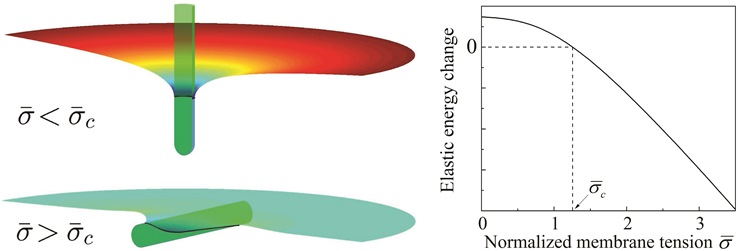
Cell uptake of 1D nanomaterials transitions from a near-perpendicular entry mode at low membrane tension to a near-parallel interaction mode at high tension. This tension-dependent behavior is observed in interactions between cell membranes and 1D nanomaterials, including carbon nanotubes, filopodia, microtubules, and particle chains.
Phase diagrams and morphological evolution in wrapping of rod-shaped elastic nanoparticles by cell membrane: A two-dimensional study. (pdf, doi)
Phys. Rev. E 89, 062712 (2014). by X. Yi and H. J. Gao

A theoretical analysis investigates the phase diagrams and morphological evolution of an elastic rod-shaped nanoparticle wrapped by a lipid membrane in two dimensions. Symmetric morphologies appear in the early and late wrapping stages, while soft nanoparticles undergo dramatic symmetry-breaking changes, and stiffer nanoparticles exhibit sharp reorientation.
Cellular uptake of elastic nanoparticles. (pdf, doi)
Phys. Rev. Lett. 107, 098101 (2011). by X. Yi et al.
Cell membrane wrapping of a spherical thin elastic shell. (pdf, doi)
Soft Matter 11, 1107–1115 (2015). by X. Yi and H. J. Gao
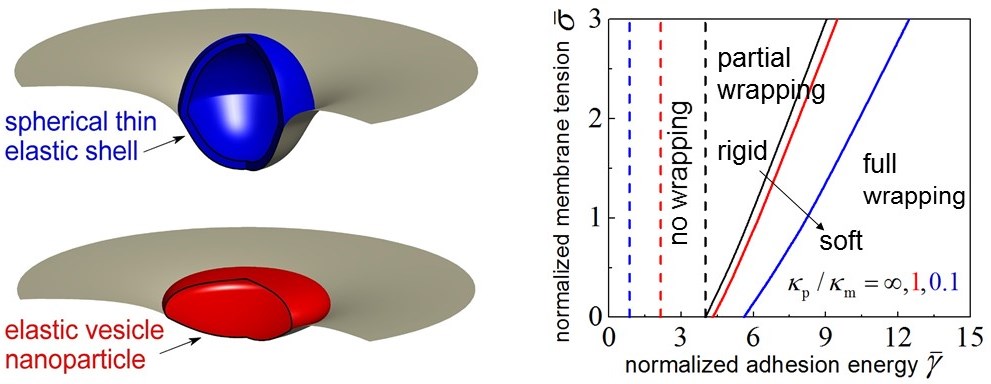
Theoretical analysis is conducted to investigate cell uptake of elastic nanoparticles, such as liposomes and polymer capsules. Stiffer particles achieve full wrapping more easily from a viewpoint of energy, while softer particles experience smaller energy changes during partial wrapping, making them advantageous when full wrapping is unnecessary. These findings offer insights into why viral particles stiffen before budding and soften during uptake. Our results suggest that precisely tuning particle elasticity provides a promising strategy to regulate cell uptake.
Water-swelling-induced morphological instability of a supported polymethyl methacrylate thin film. (pdf, doi)
Langmuir 26, 7651–7655 (2010). by B. X. Jing et al.
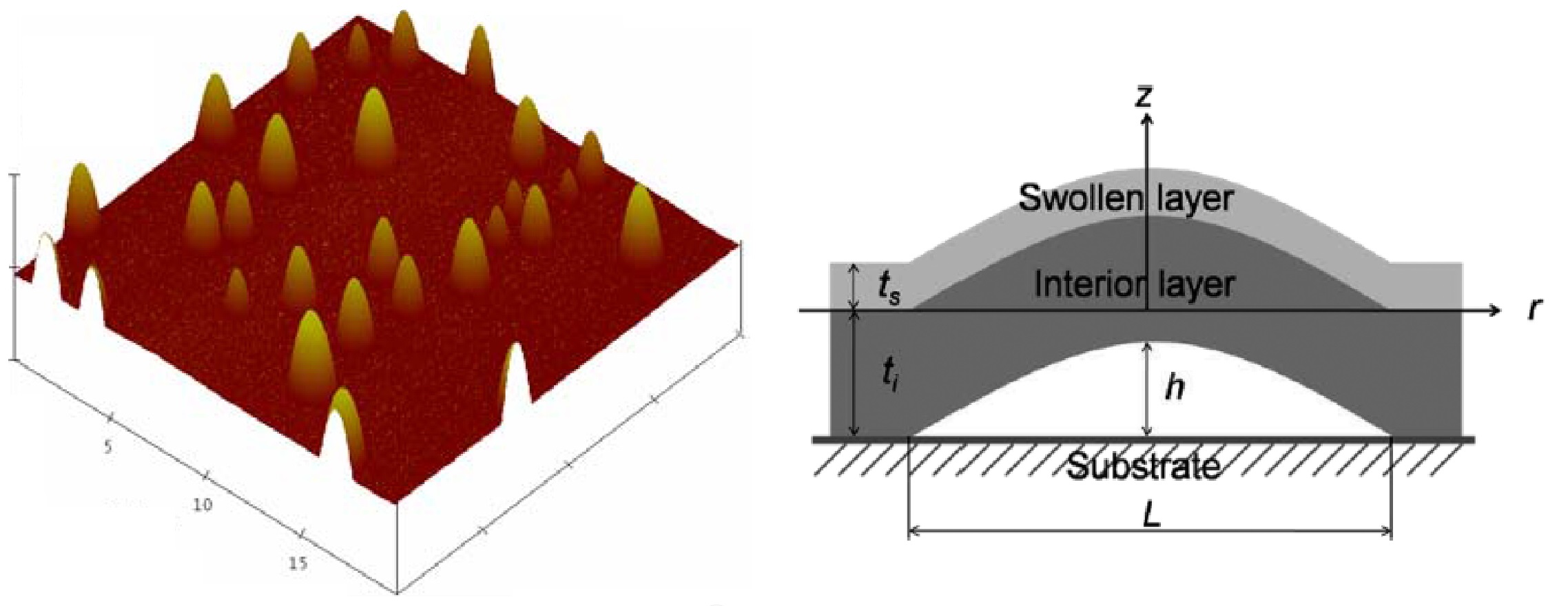
Poly(methyl methacrylate) (PMMA) thin films in water partially detach from the solid substrate, resulting in the formation of bubbles under water. The process is reversible. Theoretical analysis based on a two-layer model (swollen layer and interior layer) shows that the partial swelling of PMMA in water leads to the bubble formation.
Surface stress induced by interactions of adsorbates and its effect on deformation and frequency of microcantilever sensors. (pdf, doi)
J. Mech. Phys. Solids 57, 1254–1266 (2009). by X. Yi and H. L. Duan
Vibration of cantilevers with rough surfaces. (pdf, doi)
Acta Mechanica Solida Sinica 22, 550–554 (2009). by H. L. Duan et al.

We establish the connection between adsorption-induced surface stress and van der Waals and Coulomb interactions, rooted in the physical and chemical interactions between adsorbates and solid surfaces. Building on this foundation, we develop a theoretical framework to predict the deflection and resonance frequencies of microcantilevers, accounting for the combined effects of eigenstrain, surface stress, and adsorption mass. Further analysis reveals that the surface roughness of microcantilevers can amplify, diminish, or even negate the impact of surface stress on resonance frequency.
Prediction of complex dielectric constants of polymer-clay nanocomposites. (pdf, doi)
Phys. Lett. A 372, 68–71 (2007). by X. Yi et al.
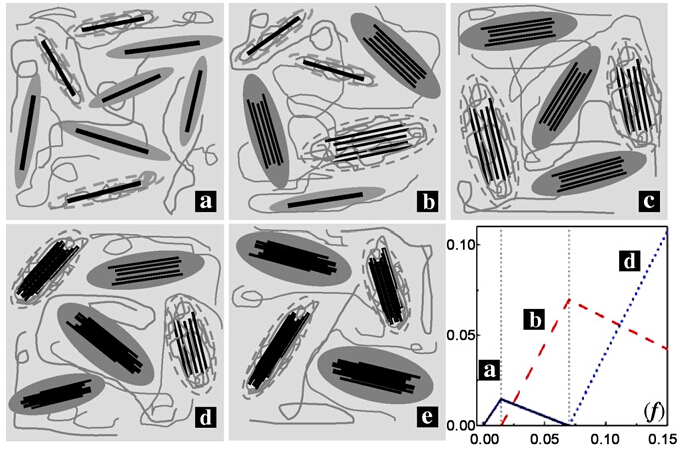
Theoretical analysis indicates that the morphology of the clay fillers and the thickness and dielectric properties of the interphases play an important role in determining dielectric properties of polymer-clay nanocomposites.
A unified scheme for prediction of effective moduli of multiphase composites with interface effects.
Part I: Theoretical framework. (pdf, doi)
Mech. Mater. 39, 81–93 (2007). by H. L. Duan et al.
Part II—Application and scaling laws. (pdf, doi)
Mech. Mater. 39, 94–103 (2007). by H. L. Duan et al.

In this two-part study, a unified theoretical framework is developed using a replacement procedure and the generalized self-consistent method (GSCM) to predict the effective moduli of multiphase composites with spherical particles or cylindrical fibers, accounting for various interface effects. Analytical solutions for the effective moduli are provided, along with numerical results validated against experimental data.
Solutions of inhomogeneity problems with graded shells and application to core-shell nanoparticles and composites. (pdf, doi)
J. Mech. Phys. Solids 54, 1401–1425 (2006). by H. L. Duan et al.
Eshelby equivalent inclusion method for composites with interface effects. (pdf, doi)
Key Eng. Mater. 312, 161–166 (2006). by H. L. Duan et al.
Eshelby formalism for multi-shell nano-inhomogeneities. (pdf, doi)
Arch. Mech. 59, 259–281 (2007). by X. Yi et al.

The Eshelby tensors and stress concentration tensors are derived for a spherical inhomogeneity with a graded shell embedded in an infinite matrix. The solution is further extended to inhomogeneous inclusions within finite spherical domains. Additionally, strain distributions in core-shell nanoparticles, arising from eigenstrains due to lattice mismatches, are calculated using the Eshelby tensors for finite domains. Within the framework of the equivalent inclusion method, these tensors for the three-phase configuration are employed to formulate a generalized self-consistent model for predicting the effective moduli of composites containing spherical particles.
Conductivities of heterogeneous media with graded anisotropic constituents. (pdf, doi)
J. Appl. Phys. 100, 034906 (2006). by H. L. Duan et al.
Effective conductivities of heterogeneous media containing multiple inclusions with various spatial distributions. (pdf, doi)
Phys. Rev. B 73, 174203 (2006). by H. L. Duan et al.
Bounds on effective conductivities of heterogeneous media with graded constituents. (pdf, doi)
Phys. Rev. B 73, 104208 (2006). by J. X. Wang et al.

The effective conductivities of heterogeneous media with discretely suspended particles featuring graded interphases or graded structures are derived using an energy equivalency condition, along with corresponding upper and lower bounds. For media with ellipsoidal inclusions of varying shapes, spatial distributions, and orientations, an alternative scheme is proposed to predict effective conductivities.
Strain distributions in nano-onions with uniform and non-uniform compositions. (pdf, doi)
Nanotechnology 17, 3380–3387 (2006). by H. L. Duan et al.
Compatible composition profiles and critical sizes of alloyed quantum dots. (pdf, doi)
Phys. Rev. B 74, 195328 (2006). by H. L. Duan et al.

The strains in embedded and free-standing nano-onions with uniform and non-uniform compositions are investigated. The strain fields in the nano-onions can be modified by adjusting their compositions and structures.
